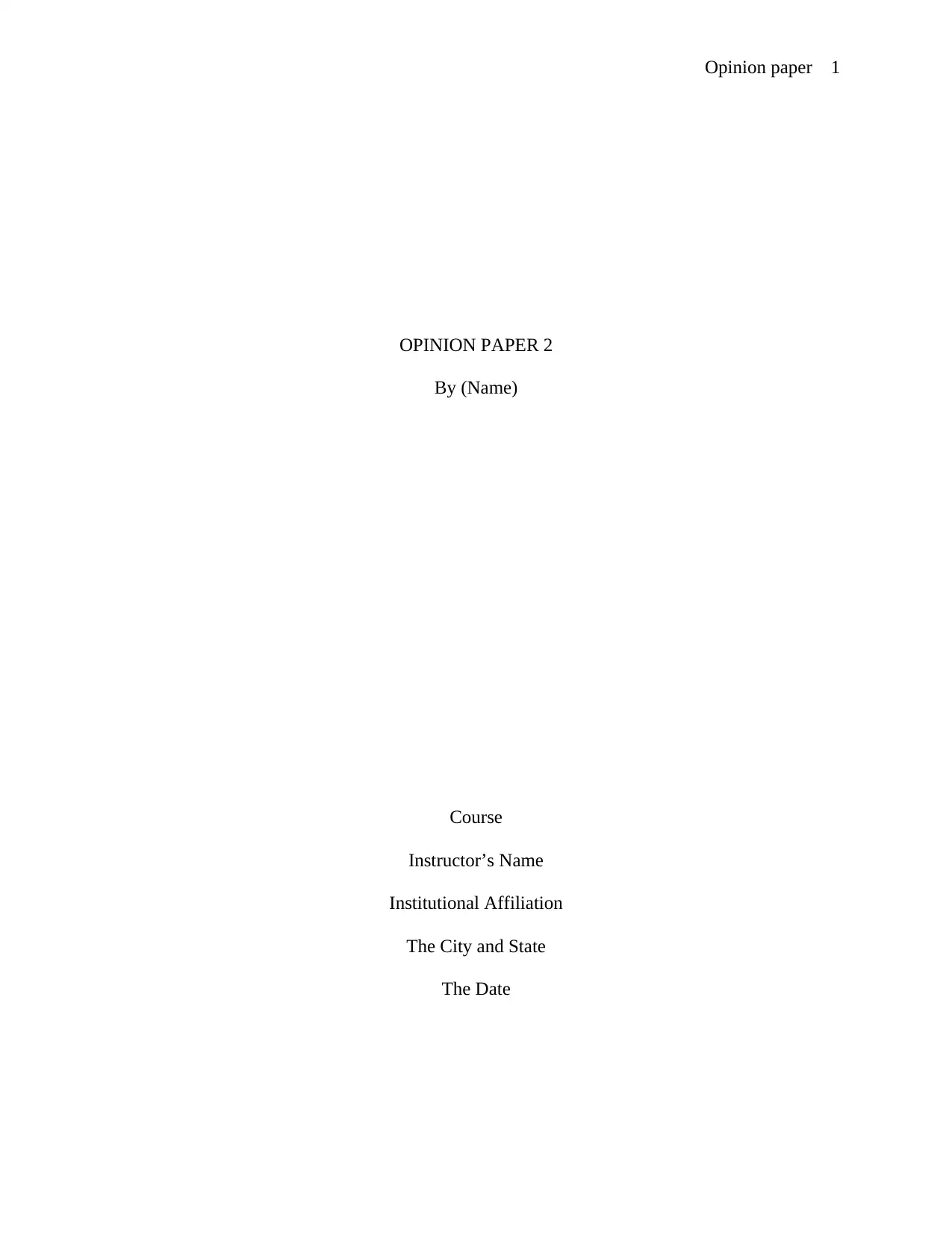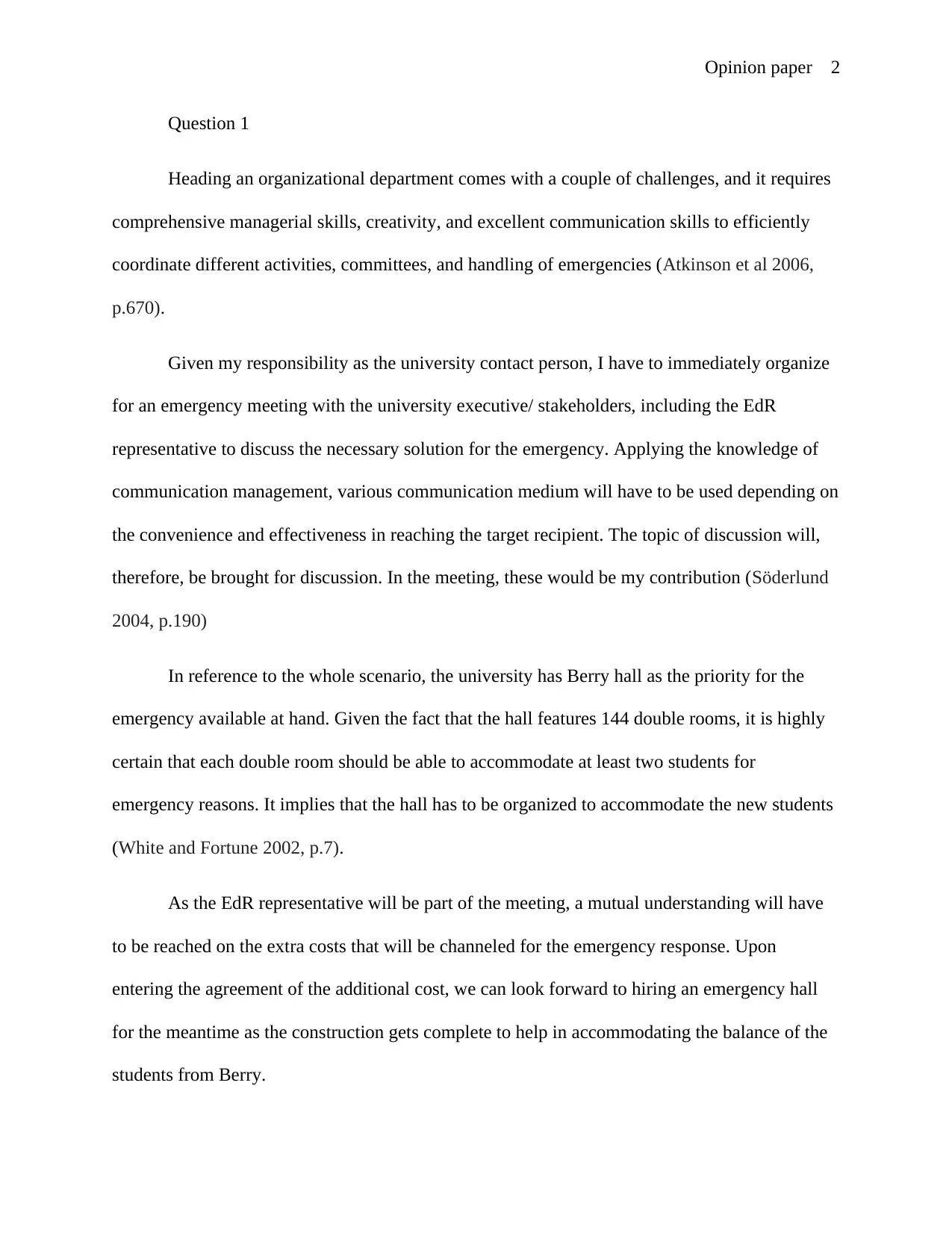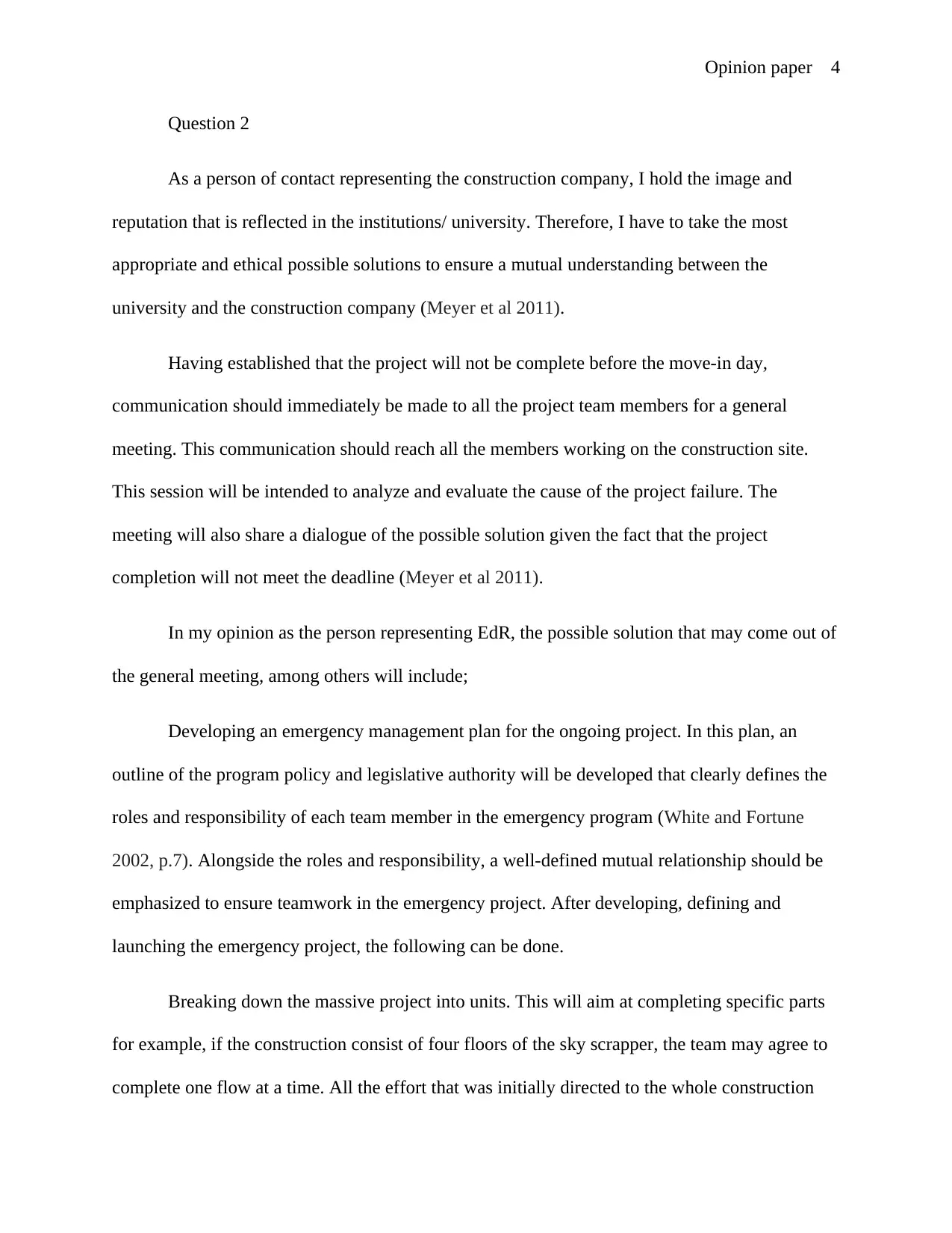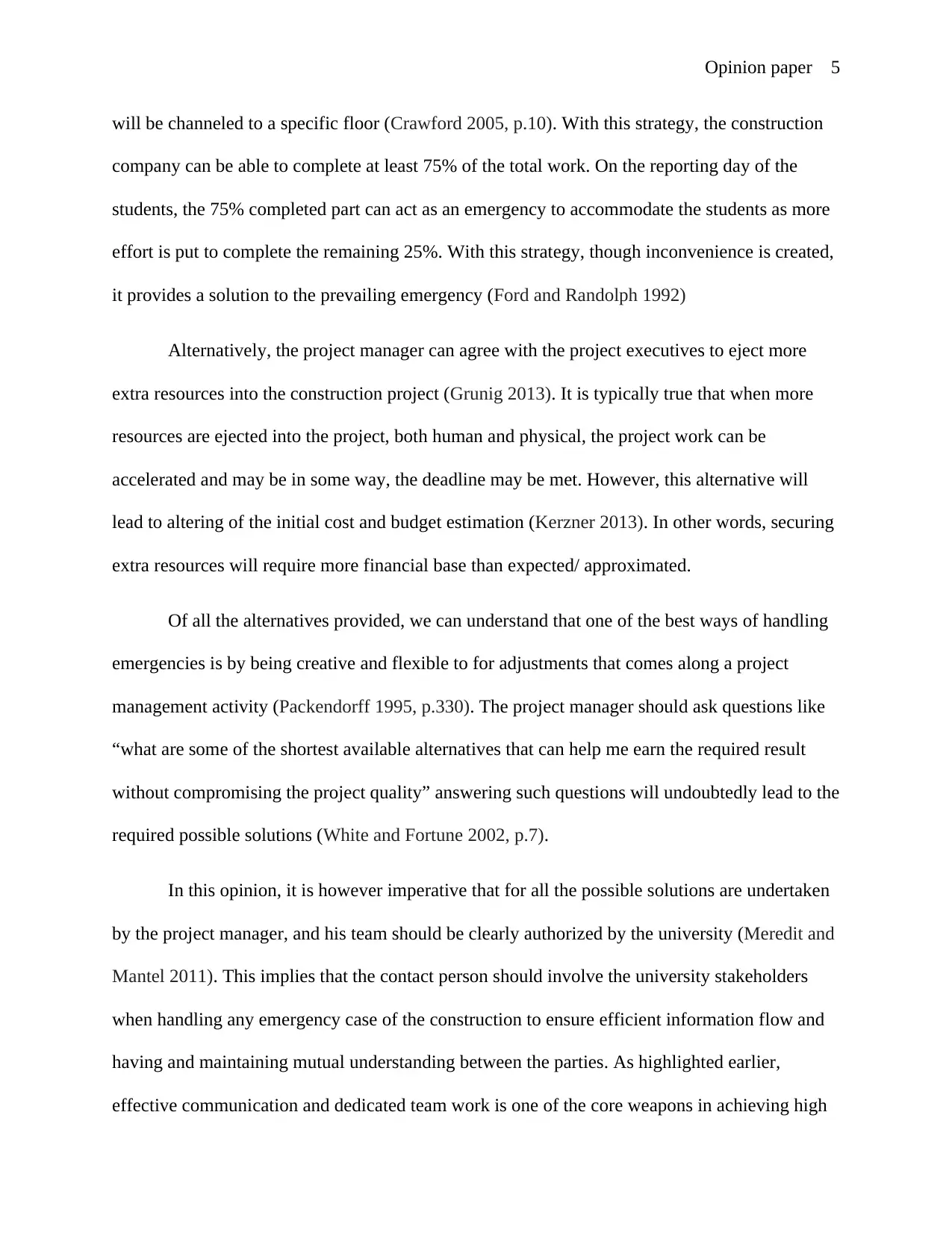Opinion Paper: Leadership and Project Management in Emergencies
VerifiedAdded on 2020/05/04
|8
|1452
|381
Report
AI Summary
This opinion paper addresses the challenges of leadership and project management, particularly in emergency situations within a construction context. The paper explores the importance of communication management, stakeholder engagement, and ethical decision-making when faced with project delays and potential failures. The author, assuming the roles of a university contact person and a representative of the construction company, outlines strategies for handling emergencies, such as organizing meetings, assessing the situation, and developing contingency plans. The paper suggests practical solutions, including utilizing available resources, breaking down large projects into manageable units, and considering the implications of postponing project deadlines. The author emphasizes the significance of teamwork, flexibility, and effective communication in achieving successful project outcomes while maintaining the university's reputation and ensuring student accommodation. The paper concludes by highlighting the need for authorized actions from stakeholders and the importance of a well-defined emergency management plan.

Opinion paper 1
OPINION PAPER 2
By (Name)
Course
Instructor’s Name
Institutional Affiliation
The City and State
The Date
OPINION PAPER 2
By (Name)
Course
Instructor’s Name
Institutional Affiliation
The City and State
The Date
Paraphrase This Document
Need a fresh take? Get an instant paraphrase of this document with our AI Paraphraser

Opinion paper 2
Question 1
Heading an organizational department comes with a couple of challenges, and it requires
comprehensive managerial skills, creativity, and excellent communication skills to efficiently
coordinate different activities, committees, and handling of emergencies (Atkinson et al 2006,
p.670).
Given my responsibility as the university contact person, I have to immediately organize
for an emergency meeting with the university executive/ stakeholders, including the EdR
representative to discuss the necessary solution for the emergency. Applying the knowledge of
communication management, various communication medium will have to be used depending on
the convenience and effectiveness in reaching the target recipient. The topic of discussion will,
therefore, be brought for discussion. In the meeting, these would be my contribution (Söderlund
2004, p.190)
In reference to the whole scenario, the university has Berry hall as the priority for the
emergency available at hand. Given the fact that the hall features 144 double rooms, it is highly
certain that each double room should be able to accommodate at least two students for
emergency reasons. It implies that the hall has to be organized to accommodate the new students
(White and Fortune 2002, p.7).
As the EdR representative will be part of the meeting, a mutual understanding will have
to be reached on the extra costs that will be channeled for the emergency response. Upon
entering the agreement of the additional cost, we can look forward to hiring an emergency hall
for the meantime as the construction gets complete to help in accommodating the balance of the
students from Berry.
Question 1
Heading an organizational department comes with a couple of challenges, and it requires
comprehensive managerial skills, creativity, and excellent communication skills to efficiently
coordinate different activities, committees, and handling of emergencies (Atkinson et al 2006,
p.670).
Given my responsibility as the university contact person, I have to immediately organize
for an emergency meeting with the university executive/ stakeholders, including the EdR
representative to discuss the necessary solution for the emergency. Applying the knowledge of
communication management, various communication medium will have to be used depending on
the convenience and effectiveness in reaching the target recipient. The topic of discussion will,
therefore, be brought for discussion. In the meeting, these would be my contribution (Söderlund
2004, p.190)
In reference to the whole scenario, the university has Berry hall as the priority for the
emergency available at hand. Given the fact that the hall features 144 double rooms, it is highly
certain that each double room should be able to accommodate at least two students for
emergency reasons. It implies that the hall has to be organized to accommodate the new students
(White and Fortune 2002, p.7).
As the EdR representative will be part of the meeting, a mutual understanding will have
to be reached on the extra costs that will be channeled for the emergency response. Upon
entering the agreement of the additional cost, we can look forward to hiring an emergency hall
for the meantime as the construction gets complete to help in accommodating the balance of the
students from Berry.

Opinion paper 3
For purposes of not compromising the quality of the construction, extra pressure should
not be exerted on the construction representative (White and Fortune 2002, p.7). This implies
that if the alternatives of hiring an additional hall alongside Berry hall fails, the university
committee will have to reach a decision on postponing the reporting date of the students.
It should be noted that the preceding opinion is based on the assumption that the
construction project will take the shortest time for its completion. In other words, the project will
not take longer than one week after the initially anticipated move-in day (Atkinson et al 2006,
p.670).
For purposes of not compromising the quality of the construction, extra pressure should
not be exerted on the construction representative (White and Fortune 2002, p.7). This implies
that if the alternatives of hiring an additional hall alongside Berry hall fails, the university
committee will have to reach a decision on postponing the reporting date of the students.
It should be noted that the preceding opinion is based on the assumption that the
construction project will take the shortest time for its completion. In other words, the project will
not take longer than one week after the initially anticipated move-in day (Atkinson et al 2006,
p.670).
⊘ This is a preview!⊘
Do you want full access?
Subscribe today to unlock all pages.

Trusted by 1+ million students worldwide

Opinion paper 4
Question 2
As a person of contact representing the construction company, I hold the image and
reputation that is reflected in the institutions/ university. Therefore, I have to take the most
appropriate and ethical possible solutions to ensure a mutual understanding between the
university and the construction company (Meyer et al 2011).
Having established that the project will not be complete before the move-in day,
communication should immediately be made to all the project team members for a general
meeting. This communication should reach all the members working on the construction site.
This session will be intended to analyze and evaluate the cause of the project failure. The
meeting will also share a dialogue of the possible solution given the fact that the project
completion will not meet the deadline (Meyer et al 2011).
In my opinion as the person representing EdR, the possible solution that may come out of
the general meeting, among others will include;
Developing an emergency management plan for the ongoing project. In this plan, an
outline of the program policy and legislative authority will be developed that clearly defines the
roles and responsibility of each team member in the emergency program (White and Fortune
2002, p.7). Alongside the roles and responsibility, a well-defined mutual relationship should be
emphasized to ensure teamwork in the emergency project. After developing, defining and
launching the emergency project, the following can be done.
Breaking down the massive project into units. This will aim at completing specific parts
for example, if the construction consist of four floors of the sky scrapper, the team may agree to
complete one flow at a time. All the effort that was initially directed to the whole construction
Question 2
As a person of contact representing the construction company, I hold the image and
reputation that is reflected in the institutions/ university. Therefore, I have to take the most
appropriate and ethical possible solutions to ensure a mutual understanding between the
university and the construction company (Meyer et al 2011).
Having established that the project will not be complete before the move-in day,
communication should immediately be made to all the project team members for a general
meeting. This communication should reach all the members working on the construction site.
This session will be intended to analyze and evaluate the cause of the project failure. The
meeting will also share a dialogue of the possible solution given the fact that the project
completion will not meet the deadline (Meyer et al 2011).
In my opinion as the person representing EdR, the possible solution that may come out of
the general meeting, among others will include;
Developing an emergency management plan for the ongoing project. In this plan, an
outline of the program policy and legislative authority will be developed that clearly defines the
roles and responsibility of each team member in the emergency program (White and Fortune
2002, p.7). Alongside the roles and responsibility, a well-defined mutual relationship should be
emphasized to ensure teamwork in the emergency project. After developing, defining and
launching the emergency project, the following can be done.
Breaking down the massive project into units. This will aim at completing specific parts
for example, if the construction consist of four floors of the sky scrapper, the team may agree to
complete one flow at a time. All the effort that was initially directed to the whole construction
Paraphrase This Document
Need a fresh take? Get an instant paraphrase of this document with our AI Paraphraser

Opinion paper 5
will be channeled to a specific floor (Crawford 2005, p.10). With this strategy, the construction
company can be able to complete at least 75% of the total work. On the reporting day of the
students, the 75% completed part can act as an emergency to accommodate the students as more
effort is put to complete the remaining 25%. With this strategy, though inconvenience is created,
it provides a solution to the prevailing emergency (Ford and Randolph 1992)
Alternatively, the project manager can agree with the project executives to eject more
extra resources into the construction project (Grunig 2013). It is typically true that when more
resources are ejected into the project, both human and physical, the project work can be
accelerated and may be in some way, the deadline may be met. However, this alternative will
lead to altering of the initial cost and budget estimation (Kerzner 2013). In other words, securing
extra resources will require more financial base than expected/ approximated.
Of all the alternatives provided, we can understand that one of the best ways of handling
emergencies is by being creative and flexible to for adjustments that comes along a project
management activity (Packendorff 1995, p.330). The project manager should ask questions like
“what are some of the shortest available alternatives that can help me earn the required result
without compromising the project quality” answering such questions will undoubtedly lead to the
required possible solutions (White and Fortune 2002, p.7).
In this opinion, it is however imperative that for all the possible solutions are undertaken
by the project manager, and his team should be clearly authorized by the university (Meredit and
Mantel 2011). This implies that the contact person should involve the university stakeholders
when handling any emergency case of the construction to ensure efficient information flow and
having and maintaining mutual understanding between the parties. As highlighted earlier,
effective communication and dedicated team work is one of the core weapons in achieving high
will be channeled to a specific floor (Crawford 2005, p.10). With this strategy, the construction
company can be able to complete at least 75% of the total work. On the reporting day of the
students, the 75% completed part can act as an emergency to accommodate the students as more
effort is put to complete the remaining 25%. With this strategy, though inconvenience is created,
it provides a solution to the prevailing emergency (Ford and Randolph 1992)
Alternatively, the project manager can agree with the project executives to eject more
extra resources into the construction project (Grunig 2013). It is typically true that when more
resources are ejected into the project, both human and physical, the project work can be
accelerated and may be in some way, the deadline may be met. However, this alternative will
lead to altering of the initial cost and budget estimation (Kerzner 2013). In other words, securing
extra resources will require more financial base than expected/ approximated.
Of all the alternatives provided, we can understand that one of the best ways of handling
emergencies is by being creative and flexible to for adjustments that comes along a project
management activity (Packendorff 1995, p.330). The project manager should ask questions like
“what are some of the shortest available alternatives that can help me earn the required result
without compromising the project quality” answering such questions will undoubtedly lead to the
required possible solutions (White and Fortune 2002, p.7).
In this opinion, it is however imperative that for all the possible solutions are undertaken
by the project manager, and his team should be clearly authorized by the university (Meredit and
Mantel 2011). This implies that the contact person should involve the university stakeholders
when handling any emergency case of the construction to ensure efficient information flow and
having and maintaining mutual understanding between the parties. As highlighted earlier,
effective communication and dedicated team work is one of the core weapons in achieving high

Opinion paper 6
quality projects. In the opinion provided, it was assumed that the project was nearing completion
but only late by a few days (White and Fortune 2002, p.7).
quality projects. In the opinion provided, it was assumed that the project was nearing completion
but only late by a few days (White and Fortune 2002, p.7).
⊘ This is a preview!⊘
Do you want full access?
Subscribe today to unlock all pages.

Trusted by 1+ million students worldwide

Opinion paper 7
References
Atkinson, R., Crawford, L. and Ward, S., 2006. Fundamental uncertainties in projects and the
scope of project management. International journal of project management, 24(8), pp.687-698.
Crawford, L., 2005. Senior management perceptions of project management
competence. International journal of project management, 23(1), pp.7-16.
Ford, R.C. and Randolph, W.A., 1992. Cross-functional structures: A review and integration of
matrix organization and project management. Journal of management, 18(2), pp.267-294.
Grunig, J.E. ed., 2013. Excellence in public relations and communication management.
Routledge.
Kerzner, H., 2013. Project management: a systems approach to planning, scheduling, and
controlling. John Wiley & Sons.
Meredith, J.R. and Mantel Jr, S.J., 2011. Project management: a managerial approach. John
Wiley & Sons.
Meyer, M., Roodt, G. and Robbins, M., 2011. Human resources risk management: governing
people risks for improved performance: opinion paper. SA Journal of Human Resource
Management, 9(1), pp.1-12.
Packendorff, J., 1995. Inquiring into the temporary organization: new directions for project
management research. Scandinavian journal of management, 11(4), pp.319-333.
Söderlund, J., 2004. Building theories of project management: past research, questions for the
future. International journal of project management, 22(3), pp.183-191.
References
Atkinson, R., Crawford, L. and Ward, S., 2006. Fundamental uncertainties in projects and the
scope of project management. International journal of project management, 24(8), pp.687-698.
Crawford, L., 2005. Senior management perceptions of project management
competence. International journal of project management, 23(1), pp.7-16.
Ford, R.C. and Randolph, W.A., 1992. Cross-functional structures: A review and integration of
matrix organization and project management. Journal of management, 18(2), pp.267-294.
Grunig, J.E. ed., 2013. Excellence in public relations and communication management.
Routledge.
Kerzner, H., 2013. Project management: a systems approach to planning, scheduling, and
controlling. John Wiley & Sons.
Meredith, J.R. and Mantel Jr, S.J., 2011. Project management: a managerial approach. John
Wiley & Sons.
Meyer, M., Roodt, G. and Robbins, M., 2011. Human resources risk management: governing
people risks for improved performance: opinion paper. SA Journal of Human Resource
Management, 9(1), pp.1-12.
Packendorff, J., 1995. Inquiring into the temporary organization: new directions for project
management research. Scandinavian journal of management, 11(4), pp.319-333.
Söderlund, J., 2004. Building theories of project management: past research, questions for the
future. International journal of project management, 22(3), pp.183-191.
Paraphrase This Document
Need a fresh take? Get an instant paraphrase of this document with our AI Paraphraser

Opinion paper 8
White, D. and Fortune, J., 2002. Current practice in project management—An empirical
study. International journal of project management, 20(1), pp.1-11.
White, D. and Fortune, J., 2002. Current practice in project management—An empirical
study. International journal of project management, 20(1), pp.1-11.
1 out of 8
Your All-in-One AI-Powered Toolkit for Academic Success.
+13062052269
info@desklib.com
Available 24*7 on WhatsApp / Email
![[object Object]](/_next/static/media/star-bottom.7253800d.svg)
Unlock your academic potential
Copyright © 2020–2025 A2Z Services. All Rights Reserved. Developed and managed by ZUCOL.